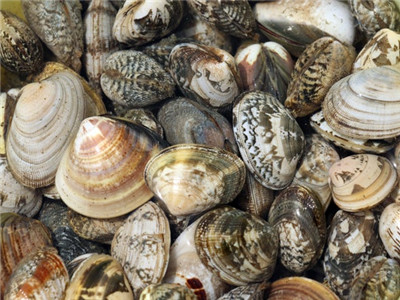(单词翻译:单击)
听力文本
This is Scientific American's 60-second Science, I'm Susanne Bard.
Around 100,000 years ago, in what is now Italy, our Neandertal cousins waded out into the shallow coastal waters of the Mediterranean Sea in search of clams. They grabbed the mollusks from the seafloor and perhaps even dived for them in deeper water. And they also simply collected clams from the beach. But the creatures weren't just food.
In a recent study, University of Colorado, Boulder, archaeologist Paola Villa and her team report that Neandertals modified the clams' hard shells into tools for cutting and scraping. The clam-derived implements were found inside the Grotta dei Moscerini, a coastal cave that was first rediscovered around 85 years ago.
By examining wear and tear on the shells, the researchers determined that about 75 percent of the tool source material had been found dead on the beach. These shells had been worn down from being battered by waves and sand. But the remaining shells were smooth and shiny, indicating that the clams were still alive on the seafloor when they were gathered.

These shells were also thicker and therefore might have made more durable tools. So even though gathering clams underwater took more work than picking them up on the beach, the effort may have been worth it.
Also found in the Grotta dei Moscerini were pumice stones from volcanic eruptions that had occurred to the south of the site. Those stones may have been used by Neandertals as abrasive tools.
The study is in the journal PLOS ONE.
Neandertals were making these tools more than 50,000 years before modern humans first arrived in Western Europe. But Neandertal intelligence was dismissed by the scientific community during much of the 20th century. In recent years, however, evidence of their tool use and even artistic abilities has grown. Neandertals hunted, made cave art, cooked with fire, used boats and went fishing. Just last year, for example, research by Villa and others found that Neandertals living not far from the Grotta dei Moscerini site used resin adhesives to attach handles to stone tools.
They may have gone extinct some 40,000 years ago, but it's becoming ever more clear that Neandertals were intelligent, creative people—who led fully human lives.
Thanks for listening for Scientific American's 60-second Science. I'm Susanne Bard.
参考译文
这里是科学美国人——60秒科学系列,我是苏珊娜·巴德。
大约10万年前,在如今的意大利,我们的尼安德特人表亲涉入地中海浅滩水域,寻找蛤蜊。他们捕获海床上的这些软体动物,甚至可能为此潜入深水。他们也会收集海滩上的蛤蜊。但这些生物对他们来说并不仅仅是食物。
在最近的一项研究中,科罗拉多大学博尔德分校的考古学家保拉·维拉及其团队报告称,尼安德特人会将蛤蜊的硬壳改造成切割和刮削的工具。这些用蛤蜊壳制造的工具在Grotta dei Mosserini洞中被发现,这个海蚀洞在约85年前首次被再发现。
通过检查贝壳的磨损情况,研究人员判定,这些工具的原始材料中,有约75%被发现时已经死在海滩上。这些贝壳因为受到海浪和沙子的侵蚀而磨损。但剩下的贝壳却光滑发亮,这说明采集时这些蛤蜊还活在海床上。
这些壳还比较厚,因此可能制造出更耐用的工具。因此,尽管在水下采集蛤蜊比在海滩上采集蛤蜊更费力,但这一努力可能是值得的。
在Grotta dei Mosserini洞中还发现了一些浮石,它们是该地南边火山喷发的产物。这些浮石可能被尼安德特人制造成研磨工具。
这项研究发表在《公共科学图书馆·综合》期刊上。
现代人首次到达西欧之前,尼安德特人制造这些工具的历史已有5万多年。但在20世纪的大部分时间里,尼安德特人的智慧都被科学界忽视了。不过近年来,有关尼它德特人使用工具甚至艺术能力的证据不断增加。尼安德特人会捕猎、绘制洞穴壁画、用火烹饪,使用船只和捕鱼。例如,就在去年,维拉和他人的研究发现,居住在离Grotta dei Moscerini洞不远的尼安德特人,会用树脂胶给石制工具粘上把手。
尼安德特人可能在大约40000年前灭绝,但日益清晰的是,尼安德特人很聪明而且富有创造力,他们过着完整的人类生活。
谢谢大家收听科学美国人——60秒科学。我是苏珊娜·巴德。
译文为可可英语翻译,未经授权请勿转载!
重点讲解
重点讲解:
1. wear down (使)磨平;(使)磨光;
The machines start to wear down, they don't make as many nuts and bolts as they used to.
机器开始出现磨损,螺母和螺钉的产量不如从前了。
2. even though 即使;尽管;纵然;
She never took a taxi, even though she could afford to.
尽管她坐得起出租汽车,但她从未坐过。
3. pick up 拿起;提起;拾起;捡起;
She bent down to pick up her glove.
她俯身去捡手套。
4. go extinct 灭绝;绝种;
Most animals went extinct because of evolution.
大部分动物的绝迹是因为进化演变之故。


